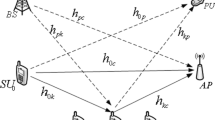Abstract
Coded cooperation is a cooperative relaying technique which is bandwidth efficient and can provide better connectivity when used with cognitive radio. Earlier cognitive radio is implemented with cooperative schemes like decode and forward, amplify and forward, compress and forward, etc., which gives moderate spectrum efficiency and diversity with reduced fading problem of wireless communication. But these techniques are not bandwidth efficient so need huge bandwidth for transmission. In this paper, we have developed a mathematical model of new coded-cooperation based multi-relay system for cognitive radio and its outage probability is analytically derived for underlay mode. The performance analysis of proposed system is carried out in terms of interference temperature constraint, channel gain, number of relays through outage probability for single and multilink relays at the primary node for Rayleigh channel. The proposed system shows that the cognitive radio with coded cooperation outperforms the already existing techniques in terms of diversity, bandwidth, spectrum utilization efficiency and improve the communication quality. In addition, the theoretical analysis of the outage probability is validated by asymptotic analysis.




Similar content being viewed by others
References
Kim, T. K., Kim, H. M., Song, M. G., & Im, G. H. (2015). Improved spectrum-sharing protocol for cognitive radio networks with multiuser cooperation. IEEE Transactions on Communications, 63(4), 1121–1135.
Jiang, C., Zhang, H., Han, Z., Cheng, J., Ren, Y., & Hanzo, L. (2016). On the Outage Probability of Information Sharing in Cognitive Vehicular Networks. In Proceedings of IEEE international conference on communications (ICC 2016), Kuala Lumpur, Malaysia.
Guo, Y., Kang, G., Zhang, N., Zhou, W., & Zhang, P. (2010). Outage performance of relay-assisted cognitive-radio system under spectrum-sharing constraints. Electronics Letters, 46(2), 182–184.
Sendonaris, A., Erkip, E., & Aazhang, B. (2003). User cooperation diversity. Part I. System description. IEEE Transactions on Communications, 51(11), 1927–1938.
Sendonaris, A., Erkip, E., & Aazhang, B. (2003). User cooperation diversity. Part II. Implementation aspects and performance analysis. IEEE Transactions on Communications, 51(11), 1939–1948.
Laneman, J. N., Tse, D. N., & Wornell, G. W. (2004). Cooperative diversity in wireless networks: Efficient protocols and outage behavior. IEEE Transactions on Information Theory, 50(12), 3062–3080.
Hunter, T. E., & Nosratinia, A. (2002). Cooperation diversity through coding. In Proceedings of 2002 IEEE international symposium on information theory, 2002 (p. 220).
Khamfroush, H., Lucani, D. E., Pahlevani, P., & Barros, J. (2015). On optimal policies for network-coded cooperation: Theory and implementation. IEEE Journal on Selected Areas in Communications, 33(2), 199–212.
Gupta, S. H., Singh, R. K., & Sharan, S. N. (2015). Performance analysis of coded cooperation and space time cooperation with multiple relays in Nakagami-m Fading. In Transactions on Computational Science XXV (pp. 172–185). Berlin Heidelberg: Springer.
Li, C., Wang, Y., Xiang, W., & Yang, D. (2011). Outage probability analysis of coded cooperation with multiple relays. In 2011 IEEE vehicular technology conference (VTC Fall) (pp. 1–5). IEEE.
Gradshteyn, I. S., & Ryzhik, I. M. (2007). Table of integrals, series, and products (3rd ed.). New York, NY: Academic.
Author information
Authors and Affiliations
Corresponding author
Appendix
Appendix
For the computation of outage probability, \(P_{out}^{a}\) is derived below as:
where, \(\alpha (x)=\frac{2^{R\varphi }}{(1+x)^{\beta }}-1\), \(\varphi =\frac{1}{1-k}\) and \(\beta =\frac{k}{1-k}\)
To proceed further with the derivation, we need to solve the inner integral of Eq. (20). After some simple mathematical manipulation, the integral \((I_{1})\) can be expressed as
where, \(A_{r_{i}d} = \frac{\lambda _{r_{i}d}}{\lambda _{up}}\).
By substituting the value of \((I_{1})\) together with the result of (5) in (20), from \((1+b)^{-L}=\sum _{l=0}^{\infty }\left( \begin{array}{c}L+l-1\\ l\end{array}\right) (-1)^{l}(b)^{l}\) and expanding it using the binomial expressions \((t-1)^{q}=\sum _{r=0}^{q}\left( \begin{array}{c}q\\ r\end{array}\right) (-1)^{q-r}(t)^{r}\), one can rewrite Eq. (20) as follows:
where, \(A_{sd} = \frac{\lambda _{sd}}{\lambda _{up}}\), \(\varphi =\frac{1}{1-k}\) and \(\beta =\frac{k}{1-k}\)
Finally using [11], eq. (3.211)] in integral \((I_{2})\), Eq. (22) can be further expressed as:
Rights and permissions
About this article
Cite this article
Singh, G., Kaur, G., Dwivedi, V.K. et al. Development of coded-cooperation based multi-relay system for cognitive radio using mathematical modeling and its performance analysis. Wireless Netw 24, 2035–2041 (2018). https://doi.org/10.1007/s11276-017-1453-x
Published:
Issue Date:
DOI: https://doi.org/10.1007/s11276-017-1453-x




